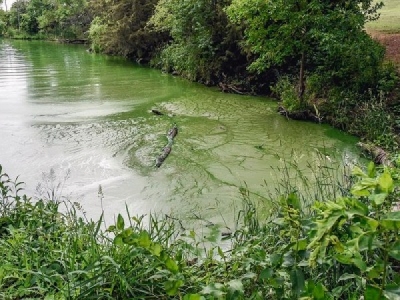
Posted on June 21, 2018
By Marcus Traxler, The Daily Republic
In excess of $10 million for the two primary options, the costs of dredging Lake Mitchell and working to solve the city’s issues with water quality are better known following Monday’s Mitchell City Council meeting.
Officials from Fyra Engineering pointed toward dredging — either mechanically or hydraulically — as its top recommendation in front of a capacity crowd in the meeting room at Mitchell City Hall.
The mechanical dredging option is estimated to cost $10,590,480, which would involve pumping the water out of the lake, removing sediment with heavy equipment and conducting post-dredging applications to attempt to neutralize future phosphorus elements from settling in the lake bottom.
A hydraulic option — at a cost of $13,359,900 — would be similar to using a Shop-Vac, Fyra’s Mike Sotek said, and would create a slurry-like material with the sediment to be hauled out and recycled to bring clean water back to the lake.
Either way, it’s recommended that 1 million dry cubic yards — called “a conservative figure” on the high side by officials — of soft sediment is to be removed from the lake and taken to another site to try to address the issues. No action was taken Monday but most of the final findings and recommendations were known. The city’s new mayor Bob Everson and council will likely take on the issue next month.
Sotek said the research made it clear that dredging would be the most likely way to solve some of the lake’s issues.
“If the city were to apply alum, it would spend millions to have temporary relief and very limited success,” said Greg Kipp, of Rapid City-based Verax Environmental Consulting.
Sotek added that a whole lake application without any dredging to apply materials and let it settle would be astronomically expensive, in excess of $18 million. The same could be said for using alum-absorbing materials and shipping them in to cap the sediment, which was projected to cost more than $20 million.
Each of dredging option has pros and cons, Sotek said. The mechanical option is more effective and is cheaper, but there are risks with potentially destabilizing the shoreline, because the current water provides pressure on the shoreline to keep it in place. The hydraulic option can basically be done in any season and doesn’t impact the shoreline as much, but also might not be as effective and costs more.
The containment site for the dredged material is also part of the equation. Sotek said taking 1 million cubic yards and spreading it over 40 acres would equate to being about 15 1/2-feet tall, but the hydraulic project would require two to three times as much space because of the water and slurry involved.
Kipp said the research group visited the site and took corings from the lake bottom in February and mapped the lake at the end of May. That mapping estimated there are about 1,920,000 cubic yards of sediment in the lake, with about 1,310,000 of that being unconsolidated, or loose, materials. When that sediment dries out, it loses about half its value.
“We learned a lot about this lake through this coring effort,” Kipp said.
The councilors’ questions primarily were based around the logistics of the dredging, including suitable sites for the material, trucking and understanding the costs. This would be the first dredging project in the state for Fyra, and Sotek said not many lakes in the state have taken on dredging projects. He said the dredging could be completed in six months’ time.
Sotek said the next steps would include the city assembling a funding package of local and outside funds that can be used for the load control project. Once a dredging project has been decided upon, the final design and permitting stage can begin to allow bidding. The city would also need to secure a location for dredging to be placed and additional sampling might take place in spring 2019 for future external loading project information.
Also proposed was a drawdown conduit, which could be used as a tool to bring the lake levels down in the future. That cost was estimated at $654,800, which would use a 42-inch pipe to manage water. An annual alum application was also among the possible recommendations, estimated to cost $425,000 each year, which Sotek noted could be important to developing a usable lake.
Source: The Daily Republic





